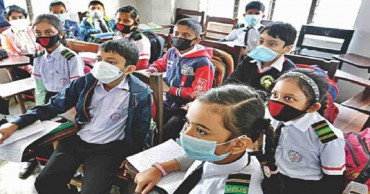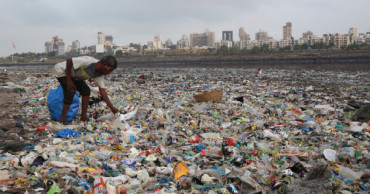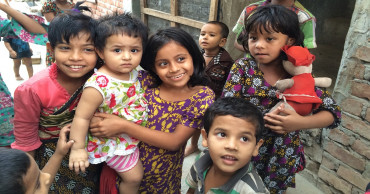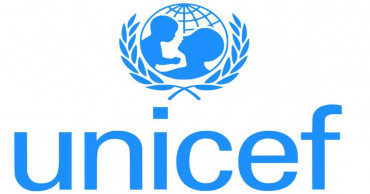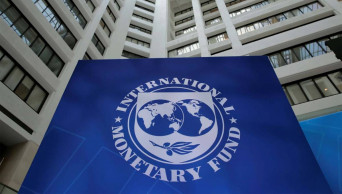risk
Millions of children at risk in Bangladesh, Myanmar in the aftermath of Cyclone Mocha: UNICEF
The trail of destruction left by Cyclone Mocha in parts of Bangladesh and Myanmar is causing severe disruption to the lives of millions of vulnerable children and families, including many already living in dire conditions, says UNICEF on Wednesday.
Even as the worst of the storm has passed, the risk of landslides remains high, and further dangers, including waterborne diseases, will likely grow in the days ahead.
Cyclone Mocha hit the coastlines of Bangladesh and Myanmar on 14 May, at around 15:00 local time, bringing heavy rainfall, storm surges, and strong winds reaching 175 mph.
"Some of the world's most vulnerable children and families are, yet again, at the sharp end of a crisis they didn't create. The areas hit hardest by the storm are home to communities already living through conflict, poverty, instability, and climate and environmental shocks," said UNICEF's Executive Director Catherine Russell.
Also read: US providing $250,000 to assist Cyclone Mocha emergency relief efforts: Peter Haas
"As we urgently assess and respond to the immediate needs of children in the aftermath of this cyclone, we know with certainty that the best way to save and improve the lives of children and their families is by finding long-term solutions."
In Bangladesh, home to the world's largest refugee camp in Cox's Bazar, one million Rohingya refugees faced the brunt of the heavy storms, half of them children. The refugee camps rank among the most tightly packed places on earth, exposing children to conditions ripe for disease, malnutrition, neglect, exploitation, and violence. The camps are also prone to mudslides, and children live in fragile temporary shelters.
Cyclone Mocha has tied with 2019's Tropical Cyclone Fani as the strongest storm ever recorded in the North Indian Ocean. Scientists recently found that, while disaster management efforts have reduced the number of deaths during cyclones in recent years, climate change is threatening this progress. They noted that escalating frequency and intensity of storms will pose a far greater risk to Bangladesh in the coming decades.
While Cox's Bazar was spared the eye of the storm, thousands of people have been affected and several temporary shelters, facilities, and infrastructure that refugees have been provided have flooded and left severely damaged due to heavy winds and rains.
Timely and urgent humanitarian access to the affected areas in both countries is critical.
UNICEF is on the ground, assessing needs, and providing emergency relief. Together with local partners, UNICEF is prepositioning and deploying supplies in Bangladesh and Myanmar to ramp up our response services, including water and sanitation, child protection, health, nutrition, and education.
By late Sunday, the storm weakened, leaving behind destroyed homes, health facilities, schools, and other critical infrastructure.
Many of the hundreds of thousands of people affected are refugees or internally displaced people (IDPs), living in poorly structured shelters in camps and hard-to-reach areas.
They rely heavily on humanitarian assistance for food, water, health, education, and protection.
The situation is particularly worrisome in Myanmar. More than 16 million people – 5.6 million of them children – including 1.2 million internally displaced people of Rohingya, ethnic Rakhine and other communities, were in the path of the cyclone in Rakhine State, and locations in the north-west including Chin State and Sagaing and Magway Regions.
The areas are low-lying and highly prone to flooding landslides.
Assessments of the extent of the damage in Myanmar are challenging, largely due to interrupted transport and telecommunication services and inaccessibility of some roads due to trees falling and debris.
However, early reports show that children were reportedly among the victims of the storm.
2 years ago
Breaching Rajuk plan: Most markets under Dhaka city corporations at fire risk
Most markets under Dhaka's two city corporations are at fire risk — major reasons being breaching the Rajdhani Unnayan Kartripakkha (Rajuk) plan and not maintaining fire service standards.
More fire incidents can occur if Rajuk and other relevant authorities do not respond promptly.
Mouchak and Anarkali markets in Dhaka’s Malibagh, Siddheshwari areas are adjacent to each other. Almost every floor of the Mouchak market has more shops than the original plan accommodates. The shops’ designs have also been altered.
Shops have even been set up in spaces that were marked as passageways within the market. From the bottom of these two markets to the four sides, there is no room in the corner. Furthermore, the entry and exit points are quite small, making these two markets prone to fire incidents.
Also Read: Fire Service’s recommendations for markets to be implemented with priority: State Minister
Meanwhile, Chandni Chawk market near New Market is also at fire risk. Condition at Chandni Chawk is similar to Mouchak’s. The Rajuk plan and requirements were not implemented at this market either.
It should be mentioned that a fire at New Supermarket — next to New Market and opposite Chandni Chawk — was devastated by a fire on April 15.
In Sayedabad Supermarket, Phulbaria Sundarban market, Nagar Plaza, City Plaza, and other markets and shopping centres, there are many more shops than the original Rajuk-approved plans allow.
Fires are also likely to occur in crowded markets with no fire extinguishing system.
Also Read: Taposh urges long-term initiative to free markets of fire risk
Similarly, Rajuk Uttara Shopping Complex has significantly more shops than the market is meant to accommodate, according to the development authority's plan. There are illegal structures everywhere, including the basement, as well as the market's entrance.
A fire service team recently visited Gausia Market and found that Rajuk rules were not followed. If a fire occurs as a result of breaching the plans, not enough people will be able to come down the stairs. Electrical wires were also seen unconcealed everywhere in the market. There is no fire alarm system either.
Except for shopping malls like Bashundhara City Shopping Complex and Jamuna Future Park, almost all markets in Dhaka city are at fire risk.
Local influential people, according to the fire department, have set up marketplaces and allotted shops at their discretion.
Also Read: 58 markets in Dhaka at risk of fire; 9 marked 'extremely risky'
These markets, according to city planner Adil Mohammad Khan, were constructed without regard to any standard or regulation. The tin-shed markets are also quite risky.
If not closely monitored, there will be more fire incidents in the future, he warned.
2 years ago
Ukrainian fears run high over fighting near nuclear plant
Ukrainians are once again anxious and alarmed about the fate of a nuclear power plant in a land that was home to the world’s worst atomic accident in 1986 at Chernobyl.
The Zaporizhzhia nuclear plant, Europe’s largest, has been occupied by Russian forces since the early days of the war, and continued fighting near the facility has heightened fears of a catastrophe that could affect nearby towns in southern Ukraine — or potentially an even wider region.
The government in Kyiv alleges Russia is essentially holding the Soviet-era nuclear plant hostage, storing weapons there and launching attacks from around it, while Moscow accuses Ukraine of recklessly firing on the facility, which is located in the city of Enerhodar.
“Anybody who understands nuclear safety issues has been trembling for the last six months,” said Mycle Schneider, an independent policy consultant and coordinator of the World Nuclear Industry Status Report.
Ukraine cannot simply shut down its nuclear plants during the war because it is heavily reliant on them, and its 15 reactors at four stations provide about half of its electricity. Still, an ongoing conflict near a working atomic plant is troubling for many experts who fear that a damaged facility could lead to a disaster.
That fear is palpable just across the Dnieper River in Nikopol, where residents have been under nearly constant Russian shelling since July 12, with eight people killed, 850 buildings damaged and over the half the population of 100,000 fleeing the city.
Liudmyla Shyshkina, a 74-year-old widow who lived within sight of the Zaporizhzhia plant before her apartment was bombarded and her husband killed, said she believes the Russians are capable of intentionally causing a nuclear disaster.
Fighting in early March caused a brief fire at the plant’s training complex, which officials said did not result in the release of any radiation. Ukrainian President Volodymyr Zelenskyy says Russia’s military actions there amount to “nuclear blackmail.”
No civilian nuclear plant is designed for a wartime situation, although the buildings housing Zaporizhzhia’s six reactors are protected by reinforced concrete that could withstand an errant shell, experts say.
The more immediate concern is that a disruption of electricity supply to the plant could knock out cooling systems that are essential for the safe operation of the reactors, and emergency diesel generators are sometimes unreliable. The pools where spent fuel rods are kept to be cooled also are vulnerable to shelling, which could cause the release of radioactive material.
Kyiv told the International Atomic Energy Agency, the U.N.’s nuclear watchdog, that shelling earlier this week damaged transformers at a nearby conventional power plant, disrupting electricity supplies to the Zaporizhzhia plant for several hours.
“These incidents show why the IAEA must be able to send a mission to the Zaporizhzhia nuclear power plant very soon,” said the agency’s head, Rafael Mariano Grossi, adding that he expected that to happen “within the next few days, if ongoing negotiations succeed.”
At a U.N. Security Council meeting Tuesday, U.N. political chief Rosemary DiCarlo urged the withdrawal of all military personnel and equipment from the plant and an agreement on a demilitarized zone around it.
Currently only one of the plant’s four power lines connecting it to the grid is operational, the agency said. External power is essential not just to cool the two reactors still in operation but also the spent radioactive fuel stored in special facilities onsite.
Read: 22 reported killed in Independence Day attack in Ukraine
“If we lose the last one, we are at the total mercy of emergency power generators,” said Najmedin Meshkati, a professor of civil and environmental engineering at the University of Southern California.
He and Schneider expressed concern that the occupation of the plant by Russian forces is also hampering safety inspections and the replacement of critical parts, and is putting severe strain on hundreds of Ukrainian staff who operate the facility.
“Human error probability will be increased manifold by fatigue,” said Meshkati, who was part of a committee appointed by the U.S. National Academy of Sciences to identify lessons from the 2011 nuclear disaster at Japan’s Fukushima nuclear plant. “Fatigue and stress are unfortunately two big safety factors.”
If an incident at the Zaporizhzhia plant were to release significant amounts of radiation, the scale and location of the contamination would be determined largely by the weather, said Paul Dorfman, a nuclear safety expert at the University of Sussex who has advised the British and Irish governments.
The massive earthquake and tsunami that hit the Fukushima plant destroyed cooling systems which triggered meltdowns in three of its reactors. Much of the contaminated material was blown out to sea, limiting the damage.
The April 26, 1986, explosion and fire at one of four reactors at the Chernobyl nuclear plant north of Kyiv sent a cloud of radioactive material across a wide swath of Europe and beyond. In addition to fueling anti-nuclear sentiment in many countries, the disaster left deep psychological scars on Ukrainians.
Zaporizhzhia’s reactors are of a different model than those at Chernobyl, but unfavorable winds could still spread radioactive contamination in any direction, Dorfman said.
“If something really went wrong, then we have a full-scale radiological catastrophe that could reach Europe, go as far as the Middle East, and certainly could reach Russia, but the most significant contamination would be in the immediate area,” he said.
That’s why Nikopol’s emergency services department takes radiation measurements every hour since the Russian invasion began. Before that, it was every four hours.
3 years ago
Polio in US, UK and Israel reveals rare risk of oral vaccine
For years, global health officials have used billions of drops of an oral vaccine in a remarkably effective campaign aimed at wiping out polio in its last remaining strongholds — typically, poor, politically unstable corners of the world.
Now, in a surprising twist in the decades-long effort to eradicate the virus, authorities in Jerusalem, New York and London have discovered evidence that polio is spreading there.
The original source of the virus? The oral vaccine itself.
Scientists have long known about this extremely rare phenomenon. That is why some countries have switched to other polio vaccines. But these incidental infections from the oral formula are becoming more glaring as the world inches closer to eradication of the disease and the number of polio cases caused by the wild, or naturally circulating, virus plummets.
Since 2017, there have been 396 cases of polio caused by the wild virus, versus more than 2,600 linked to the oral vaccine, according to figures from the World Health Organization and its partners.
“We are basically replacing the wild virus with the virus in the vaccine, which is now leading to new outbreaks,” said Scott Barrett, a Columbia University professor who has studied polio eradication. “I would assume that countries like the U.K. and the U.S. will be able to stop transmission quite quickly, but we also thought that about monkeypox.”
The latest incidents represent the first time in several years that vaccine-connected polio virus has turned up in rich countries.
Earlier this year, officials in Israel detected polio in an unvaccinated 3-year-old, who suffered paralysis. Several other children, nearly all of them unvaccinated, were found to have the virus but no symptoms.
In June, British authorities reported finding evidence in sewage that the virus was spreading, though no infections in people were identified. Last week, the government said all children in London ages 1 to 9 would be offered a booster shot.
In the U.S., an unvaccinated young adult suffered paralysis in his legs after being infected with polio, New York officials revealed last month. The virus has also shown up in New York sewers, suggesting it is spreading. But officials said they are not planning a booster campaign because they believe the state's high vaccination rate should offer enough protection.
Genetic analyses showed that the viruses in the three countries were all “vaccine-derived,” meaning that they were mutated versions of a virus that originated in the oral vaccine.
The oral vaccine at issue has been used since 1988 because it is cheap, easy to administer — two drops are put directly into children's mouths — and better at protecting entire populations where polio is spreading. It contains a weakened form of the live virus.
Read:WHO updates Covid strategy to vaccinate all health workers, vulnerable groups
But it can also cause polio in about two to four children per 2 million doses. (Four doses are required to be fully immunized.) In extremely rare cases, the weakened virus can also sometimes mutate into a more dangerous form and spark outbreaks, especially in places with poor sanitation and low vaccination levels.
These outbreaks typically begin when people who are vaccinated shed live virus from the vaccine in their feces. From there, the virus can spread within the community and, over time, turn into a form that can paralyze people and start new epidemics.
Many countries that eliminated polio switched to injectable vaccines containing a killed virus decades ago to avoid such risks; the Nordic countries and the Netherlands never used the oral vaccine. The ultimate goal is to move the entire world to the shots once wild polio is eradicated, but some scientists argue that the switch should happen sooner.
“We probably could never have gotten on top of polio in the developing world without the (oral polio vaccine), but this is the price we’re now paying,” said Dr. Paul Offit, director of the Vaccine Education Center at the Children’s Hospital of Philadelphia. “The only way we are going to eliminate polio is to eliminate the use of the oral vaccine."
Aidan O’Leary, director of WHO's polio department, described the discovery of polio spreading in London and New York as “a major surprise,” saying that officials have been focused on eradicating the disease in Afghanistan and Pakistan, where health workers have been killed for immunizing children and where conflict has made access to some areas impossible.
Still, O'Leary said he is confident Israel, Britain and the U.S. will shut down their newly identified outbreaks quickly.
The oral vaccine is credited with dramatically reducing the number of children paralyzed by polio. When the global eradication effort began in 1988, there were about 350,000 cases of wild polio a year. So far this year, there have been 19 cases of wild polio, all in Pakistan, Afghanistan and Mozambique.
In 2020, the number of polio cases linked to the vaccine hit a peak of more than 1,100 spread out across dozens of countries. It has since declined to around 200 this year so far.
Last year, WHO and partners also began using a newer oral polio vaccine, which contains a live but weakened virus that scientists believe is less likely to mutate into a dangerous form. But supplies are limited.
To stop polio in Britain, the U.S. and Israel, what is needed is more vaccination, experts say. That is something Columbia University's Barrett worries could be challenging in the COVID-19 era.
“What’s different now is a reduction in trust of authorities and the political polarization in countries like the U.S. and the U.K.,” Barrett said. “The presumption that we can quickly get vaccination numbers up quickly may be more challenging now.”
Oyewale Tomori, a virologist who helped direct Nigeria’s effort to eliminate polio, said that in the past, he and colleagues balked at describing outbreaks as “vaccine-derived,” wary it would make people fearful of the vaccine.
“All we can do is explain how the vaccine works and hope that people understand that immunization is the best protection, but it’s complicated,” Tomori said. “In hindsight, maybe it would have been better not to use this vaccine, but at that time, nobody knew it would turn out like this.”
3 years ago
Almost 6 million primary, secondary students at risk of learning loss
Around 6 million primary and secondary students are at risk of learning loss due to the extended closure of the educational institutions in the country amid the Covid-19 pandemic, according to a study report revealed Monday.
Since the closure of schools in March 2020, there have been severe disruptions in the education of children, especially those from low-income groups.
The extended closure has led to far-reaching consequences including an increased risk of learning losses, dropouts, and psychological and economic costs, says the survey "Covid-19 Impact on Education Life of Children."
Also read: Schools for over 168mn children globally shut for almost a full year: UNICEF
Some 3.42 million are primary school students and 2.50 million secondary school students are now at risk of learning loss.
Power and Participation Research Center (PPRC) and Brac Institute of Governance and Development (BIGD) jointly conducted the rapid telephonic survey between April 2020 and March 2021 to assess the impact of Covid-19 on poverty. It used samples from 6,099 households with around 4,940 consisting of school-going-age children.
Between June 2020 and March 2021, the out-of-pocket expenditure for education increased 11 times. The crisis has increased the opportunity cost of investing in education. Some 8% of school-going boys and 3% of school-going girls are in some form of income-earning activity.
Read No assignments for secondary school students
Without targeted remedial measures, the situation will lead to reduced learning capacity or risk of dropouts in future, says the study.
The survey also revealed that only around 10% of students had access to or used distance learning opportunities to compensate for school closure; public TV classes were viewed by only around 2%.
Some 51% in primary and 61% secondary students went to coaching or private tuition. However, it was lower in urban compared to rural primarily due to higher costs.
Read UN alarm at education crisis: 258 million kids not in school
Even in pre-pandemic times, a greater proportion of secondary school-going-age children were out of school (21%) than primary (14%). More children were out of school in urban slums than rural areas at both primary and secondary levels.
"A significant portion of school-going children are at risk of learning loss. So, school reopening must be coupled with a set of remedial measures to cover the learning loss and help children to cope up," said BIGD Executive Director Dr Imran Matin.
PPRC Chair Dr Hossain Zillur Rahman focused on three main consequences of school closures – learning loss, education cost burdens, and multidimensional social alienation.
Also read: 60.5 percent people in favour of reopening schools: Survey
He said outside class hours, additional programmes are required as a learning loss recovery strategy to mitigate the loss as part of a post-Covid human capital agenda. "Otherwise, a large part of our population will not only be far removed from education but also become deskilled," he added.
Dr Zillur recommended that existing primary and secondary stipend programmes be used to redress the out-of-pocket education cost burdens.
"Using the established database, the government can quickly provide a cash boost by allocating Tk2,960 crore in the 2021-22 budget," he said.
Read 86,452 primary students get stipend, allowance through Nagad in phase 1
4 years ago
Scientists gather to study risk from microplastic pollution
Tiny bits of broken-down plastic smaller than a fraction of a grain of riceare turning up everywhere in oceans, from the water tothe guts of fish and the poop of sea otters and giant killer whales.
5 years ago
1 lakh kids born in Bangladesh with blindness risk every year: Experts
Ophthalmologists here have said over 100,000 children born in Bangladesh every year face the risk of blindness and they may lose the eyesight anytime if not given proper treatment.
5 years ago
Children at risk in Libyan conflict: UNICEF
Children in Libya, including refugee and migrant children, continue to suffer grievously amid the violence and chaos unleashed by the country's longstanding civil war, said UNICEF Executive Director Henrietta Fore on Friday.
5 years ago
Rising sea levels put one-third Bangladeshis at risk of displacement: IMF
Dhaka, Sept 20 (UNB) - International Monetary Fund (IMF) has said Bangladesh is considered especially vulnerable to climate change with one-third of its population at risk of displacement because of rising sea levels.
6 years ago


.jpg)

